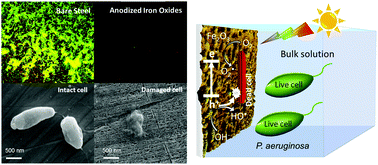Photocatalytic anti-bioadhesion and bacterial deactivation on nanostructured iron oxide films†
Abstract
Bacterial adhesion and biofilm formation on metals are a primary mechanism causing integrity degradation and failure of engineering structures. Conventional anti-bioadhesion methods usually impact the sustainability of environments and ecosystems. In this work, nanostructured iron oxide films were fabricated by electrochemical anodization of steel in a concentrated alkaline solution. The morphology, surface roughness, composition and photoelectrochemical properties of the nano-films were characterized, and the anti-adhesion properties of the films to Pseudomonas aeruginosa bacteria were investigated. A photoelectrochemical based model was developed to explain mechanistically the photocatalytic anti-bioadhesion and bacterial deactivation of the iron oxide nano-films. Results demonstrate that the nanostructured iron oxide films enable effective anti-adhesion of the bacteria to the filmed steel. The photocatalytic activity of the nano-films further deactivates the bacteria remaining on the specimen surface under visible light illumination. In particular, the nano-film formed by 10 min of anodization features the largest surface roughness, the highest photocatalytic activity, and the best performance for anti-bioadhesion and bacterial deactivation. Compared to bare steel, a 99.9% anti-bioadhesion performance is achieved. The nanostructured iron oxide films can deactivate the bacteria remaining on the film surface due to oxidative holes and reactive oxygen species generated during photo illumination.



 Please wait while we load your content...
Please wait while we load your content...